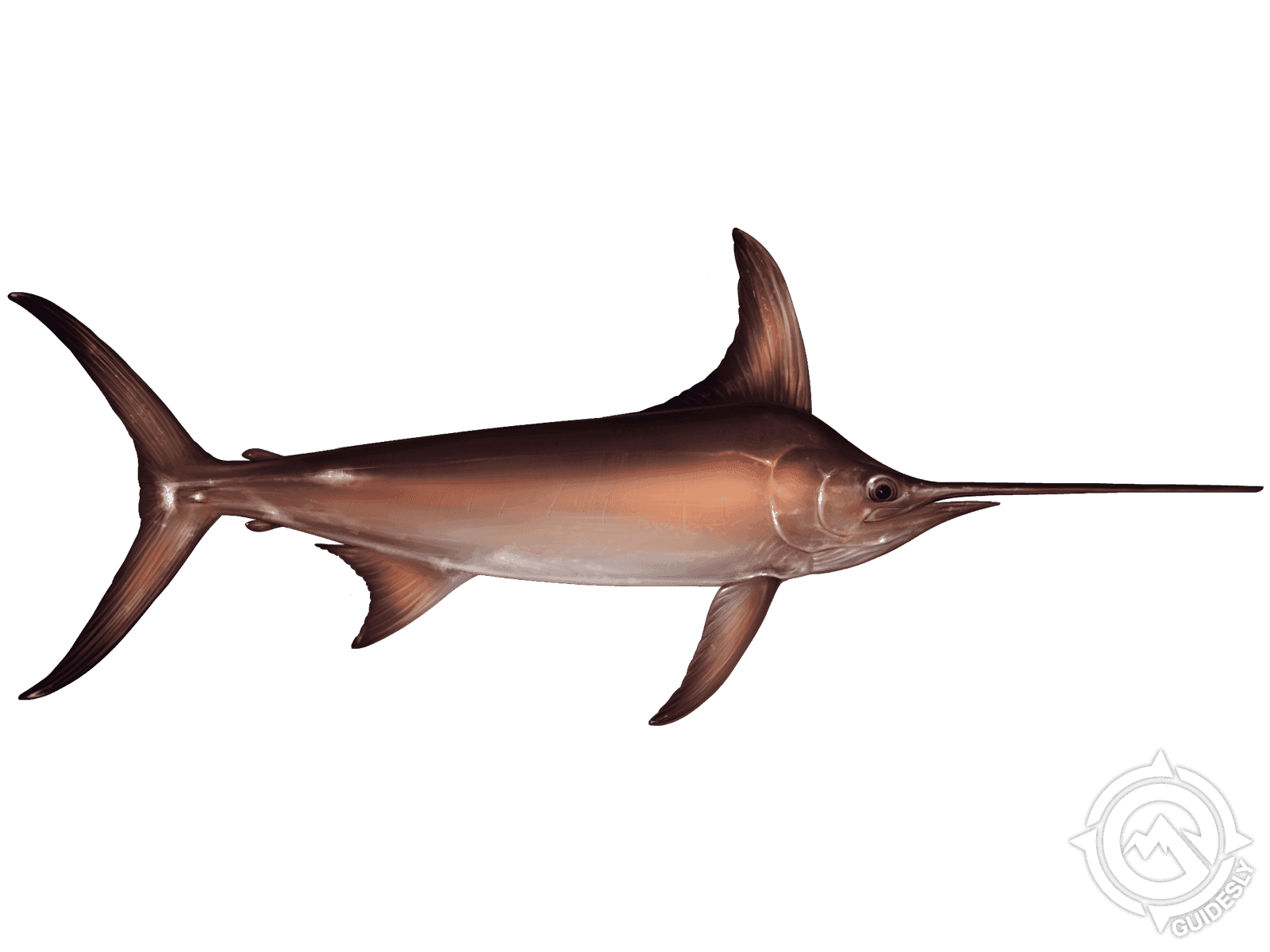Swordfish

Species Details
Xiphias Gladius
Xiphiidae
Perciformes
Offshore, Deepwater
100 - 400 lbs.
48" - 179"
What makes a Swordfish special?
Swordfish possess specialized organs near their eyes that provide warmth to their eyes & brains, resulting in improved vision & cognitive strength- making them leading powerful predators. The capture of a Swordfish is an endeavor most anglers seek to conquer; demanding immense perseverance & adeptness to interpret sea charts and devices.
Swordfish (Xiphias gladius) Fish Description
The Swordfish is a famous saltwater fish found all over the world. It’s a large predatory fish, scaleless fish with an elongated body and a sword-like snout called a bill. It’s grey-blue at the top, has a yellow horizontal line in the middle, and has a silver belly. Unlike other billed fish in which the shape is round, the swordfish’s snout is flat.
Interesting Facts
- Swordfish are the sole member of their family, Xiphiidae. They may look like marlins, but they’re not related.
- Swordfish, like sharks, are ectothermic, meaning they use particular organs to heat their body. The swordfish use it on their eyes and brain. This helps them see more in the dark depths of the ocean.
- Swordfish and other billed fish like Marlin do not spear their prey. They slash their target back and forth with their bills, stunning them, and then eat the unmoving prey.
- Female swordfish can produce an astounding 29 million eggs.
- Nutrition Facts: A 3-ounce serving of grilled swordfish contains 108 milligrams of EPA and 656 milligrams of docosahexaenoic acid, or DHA. According to the Department of Health and Human Services, eating at least 8 ounces of seafood per week may lower your risk of cardiac death.
Size and Speed
Swordfish are large, their average length is 9 feet long, but they can grow as big as 15 feet. They’re also a pretty heavy fish weighing in at 400 lb on average, but the record weight is 1,182 pounds.
They are one of the fastest fish on Earth. These fish can reach an incredible 40-60 mph.
Habitat and Distribution

Swordfish is a hardy fish found in all oceans, whether warm or cold water, though they mostly prefer warm waters (64 to 72°F). They are highly migratory, moving to warmer waters in the winter and cooler waters in the summer. Their peak spawning is from April to September. They live in deep waters with depths of 1500 feet. Aside from humans and the occasional orca, adult swordfish have few predators. Juvenile swordfish are much more vulnerable to predation and are consumed by a wide range of predatory fish.
North Atlantic Swordfish migrate thousands of miles annually along the eastern seacoast of the United States and Canada. They are found throughout the year in the Gulf of Mexico, the Caribbean, and Florida. These highly migratory meso-pelagic fish are also found throughout the Atlantic and Mediterranean sea. Great spots for fishing swordfish are in Florida Keys, Islamadora, Florida, Southern California, and Virginia Beach.
Diet
The swordfish is a carnivorous opportunistic hunter that eats various smaller fish and invertebrates such as squids.
Fishing Techniques - How to Catch Swordfish
You can fish Swordfish in the daytime or nighttime. These predators are primarily nocturnal feeders and feed at depths of 300 feet during the night, and they go deeper during the day.
They are deep-dwelling fish, and the usual method of fishing is deep-trolling. Always check the current, as your gear will also depend on how the strong current. Drop a 15 lb lead to help the bait stay at the bottom. Use several lights; usually, 2-3 are enough (both for daytime and nighttime).
Recommended gear is a 6-foot fast action rod with a 5-7 feet leader with 300-600 lb swivel, around the 45-50 feet of the line; attach your lights. Use 9/0 to 11/0 hooks, as they have pretty big mouths. Use a 32-ounce sinker if the current is pretty strong, but if not, a 24-ounce one will work. The sweet spot for swordfishing is 80-120 lb line weight (You’ll never know if you might hit an 800 lb fish).
Though rare, some fly fishing anglers successfully caught a swordfish with a fly rod (though what they caught were the smaller ones). You can use a 20-lb snippet with a 14-weight rod and a large 9/10 reel with 10/0-11/0 hooks. If you’re one of those extreme fly fishermen, this gear setup might work for you.
Use lures that are brightly colored and with a skirt to help the bait glide gracefully in deep waters. These large fish species have big eyes that they use to catch their prey in the deep; a slight glistening of the lure will attract them and take your bait. Swordfish’s favorite bait is the squid, but you can also use chunks of barracudas and other pelagic fish.






